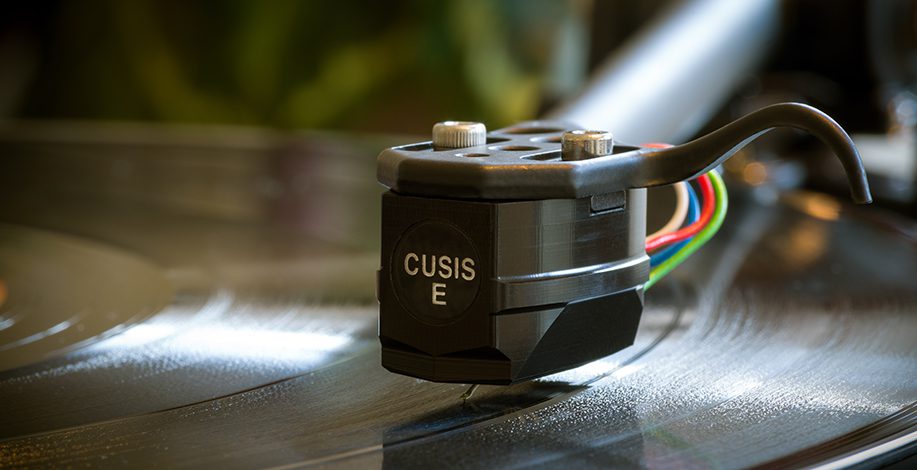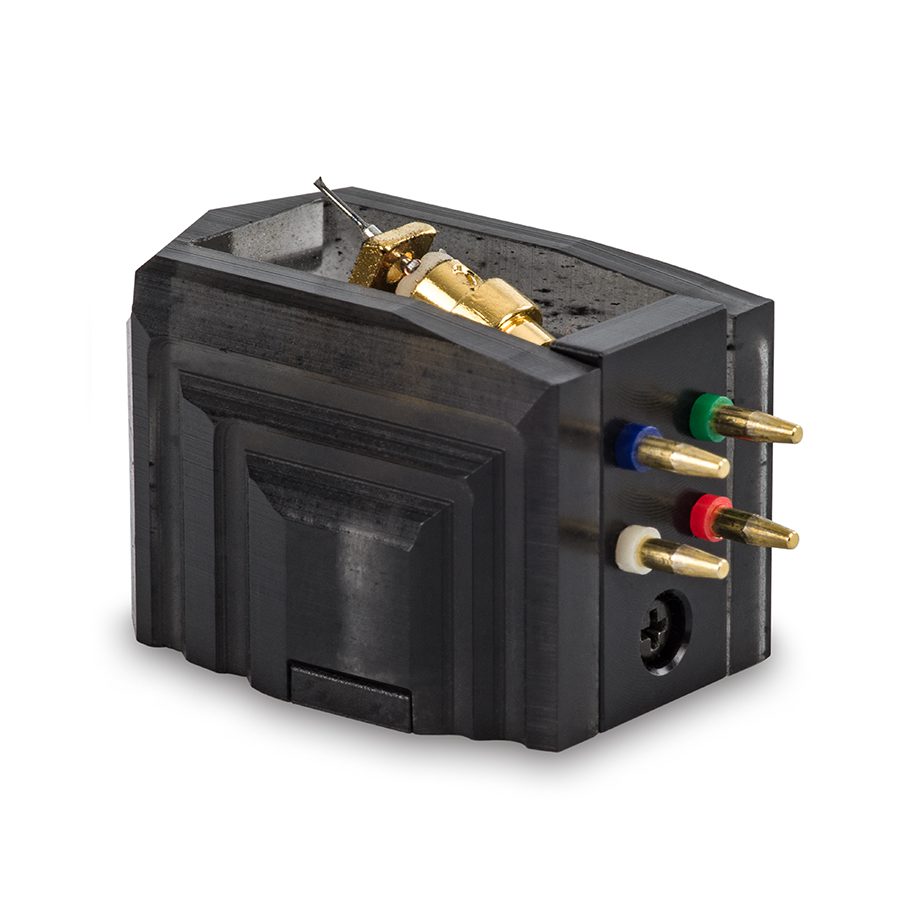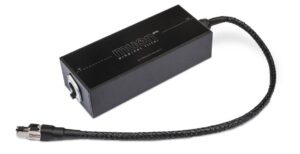
Cusis is a cartridge. It inhabits a space left almost conspicuously empty on the end of the tonearm since Michell Audio first emerged as a maker of turntables in the late 1960s. Although, then it was commonly known as Michell Engineering. With the introduction of the early Fluid arm, then more recently the TecnoArm, a pickup cartridge was the one part required to make a complete record player.
Cusis is a family of cartridges, numbering three with the Cusis E, Cusis S and Cusis M variants. All moving-coil designs are based around the same body shape (if not material), providing a range of prices and performance levels. There’s more to differentiate the Michell Audio Cusis cartridges than just the stylus profile, although the choice between elliptical, Shibata and micro-line gives a useful starting point for their designations. They’re priced at £730 for the entry Cusis E, £1,350 for the S and £2,400 for the top M model.
Michell Audio designed and built up each cartridge in-house, using a custom-made generator and stylus assembly from a Japanese OEM. All take the same body shape, a plastic shell with parallel sides machined from opaque black ‘acetyl’ [sic] – otherwise known as Delrin or polyoxymethylene (POM) – in the case of the E and S models; and a darkly smoked acrylic loaded with carbon flecks for model M. Viewed from the underside we see the classic moving-coil generator exposed, with tiny x-shaped wound armature and gold-plated metalwork.
Best of three
It may come as little surprise that the Cusis M is the best-sounding of the three, although it clearly ought to be at nearly twice the price of the middle S model. Specified at just 250µV output it’s at the lower end of the spectrum, deserving a decent low-noise phono stage to do it justice. For these evaluations, I turned to the commendable Rothwell Signature One, a solid-state phono amplifier with valve-like fluidity, fronted with internally tapped Lundahl step-up transformers. The best results were had with the low-gain 1:10 setting, which gives the most extended bass, and compensation for the reduced level was made by raising the volume a few clicks on the Music First Audio pre-amp.
While S and M models have different stylus profiles, both Shibata and micro-line styli fall in the line-contact camp, the Shibata being perhaps the earliest example of an ultrasonic-optimised profile, and the later micro-line design another refinement again to get even closer to the cutting head shape. In contrast to the Cusis E with its simple elliptical diamond and budget aluminium cantilever, Cusis S and M are treated to higher-calibre boron cantilevers, an important step toward more accurate tracing.
Besides outward body shape, all Michell Audio Cusis cartridges share the same magnetic circuit comprising samarium-cobalt magnets and iron polepieces, along with similar electrical circuits of 30µm pure copper wire. While the M would seem to have fewer windings, which means the lowest output and least moving mass, the S model has the highest specified output of 400 µV – albeit still a little lower than the typical ‘average’ low-output class of 500µV – while the E sits in-between at a nominal 350µV.
Dial M for Music
It may not be hewn from exotic lacquered hardwood like an artisan Japanese pickup. Still, the Cusis M, with its carbon-loaded acrylic body, presents as a lyrical performer, splendid at finding the colour and vibrancy of a good concerto recording. Among its high points, I was struck by the nimble fretwork of John Williams fronting the Philadelphia Orchestra, his first 1965 recording of the piece; the guitar was always clearly set apart from the reverberant orchestra behind, every note fluid and traceable. The second movement enthralled me right to the final cheeky plucked harmonic note.

Cusis M excelled at gliding through solo piano pieces, and the masterful recital of Les Adieux by Alfred Brendel was made more intense not just by M’s consummate tracking of dynamic peaks but also by the hush of his teasing silences. Aided by some scrupulous setup with a SMARTractor, surface noise was absent on this high-grade Philips pressing. Initial horizontal alignment did, however, prove more challenging than with most cartridges though, as the large body shell effectively hides most of the cantilever when viewed from the front, glasses of different strengths were required to peer under the shell from different perspectives so magnifying to confirm exact parallelism with the protractor’s laser-cut hairlines.
More than any other, Cusis M would conjure all the air and space around the music, replayed with something like the organic feel of a japanned rosewood transducer, only with consummate neutrality and even-handedness.
Es are good
Stepping back to the entry-level Cusis, Brendel’s Beethoven sonata was now smooth and mellow to a fault, and the space around the piano reined in. Still, the E provided more than a workmanlike rendition of ‘simple’ solo instrumental music. Unleashed on denser prog rock though, the Cusis E struggled to unglue the wash of instruments on Camel’s debut album. Notably, the ever-ethereal Mellotron string sound that sits at the back of ‘Never Let Go’ was lost in the crowd of organs, drums and Les Paul. Pace was highlighted, perhaps even exaggerated, and in fact, the track showed how the Cusis E implemented the song name, even if percussively, the attack of sticks and skins was rather limited.

It was an omission from various tracks from the second Yes album, Time and A Word, where the surprising string section lost its bright incision. That’s probably a kinder edit, though, than to overplay their strident contribution, a useful effect of a well-damped cantilever, which means we find a more approachable playback than when striving for a faithful replay of the edgy strings. End-of-side tracks also suffered somewhat, getting a tad coarse and messy, an often unavoidable issue with fatter elliptical styli that struggle with the tiny wavelengths. And here there’s a useful trade-off with the simple profile, in that vertical alignment is much easier, and once ‘in’ will work better across a range of records cut at different angles.
S for sugar
Hundreds of sides of vinyl were enjoyed with the Michell Audio Cusis cartridges in all three forms, but the version I spent longest deliberating over must have been the Cusis S. I wanted it to be as good as the M, and in the key areas of quiet groove, trackability and even-headed neutrality – that is, to provide a smooth response that won’t draw attention to itself – it is more than highly accomplished. Electronica from Air, Depeche Mode, Massive Attack and the Orb carried weight and drive, synths and samples filling the room, even if I missed the seemingly sub-bass reach and the textures the M showed here. And from the Yes selection, vocals were not quite so palpably ‘there’ in space. But here’s the but. For £1,300 the Cusis S is a rocking good cartridge which does the job supremely well and without any serious criticism. As always with a line-contact stylus it is extremely fussy about azimuth and vertical alignment if you really want to get the next-to-no distortion sound, and as ever the rewards for getting it right – on nearly a record-by-record basis in the case of VTA – are simply rapturous.

Ultimately what I missed from the S was the more transparent and natural midband available with the M, along with its better description of bass instrumental timbre. Yet judged by value the Cusis S is the stand-out cartridge from this troika. Thanks I’m sure to its slim profile Shibata nude stylus affixed to stiff boron cantilever it’s a cracking little tracker that will find a lot of music hidden in vinyl both old and new. Sure enough it doesn’t have the same stereo holography and bass authority as the M but it ticks the right boxes for neutrality and technical exposition.
Verdict
Rival brands include similar-specified cartridges with E/S/M stylus profiles, although economies may be made in choice of other components, using lower-performance cantilevers or magnets, for example. In the range of Michell Audio Cusis cartridges, if you can stretch to the Cusis M, it’s undoubtedly one sweet cartridge and one to beat in the circa-£2k market. And while the S is now a few hundred pounds over the sensitive grand price point it earns its place as the true Goldilocks cartridge – just right in its middle category, distinctly far from budget-sounding and in sheer musical satisfaction terms really not too dear either.
Technical specifications
- Type: Low-output moving-coil phono cartridge
- Stylus/Cantilever: Elliptical/aluminium (E); Shibata/boron (S); micro-line/boron (M)
- Tracking Force: 2.0 g
- Load: 100 ohm
- Compliance: 8 × 10–6 cm/dyne
- Output: 0.35 mV (E); 0.4 mV (S); 0.25 mV (M)
- Weight: 8.9 g (E & S); 8.1 g (M)
- Price: £730 (E); £1,350 (S); £2,400 (M)
Manufacturer
JA Michell Engineering Limited
+44 (0)208 953 0771
UK Distribution
PMC Distribution Ltd
Tags: CUSIS E CUSIS M CUSIS S MICHELL AUDIO MOVING COIL CARTRIDGE
By Andrew 'Harry' Harrison
More articles from this authorRead Next From Review
See all
PrimaLuna EVO 100 phono preamplifier
- Apr 22, 2024

Reiki Audio SuperSwitch Master Pro + Servant Pro
- Mar 27, 2024

Melco Audio N1-S38 music server
- Mar 27, 2024











